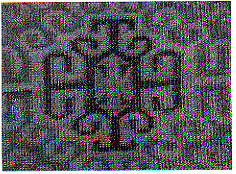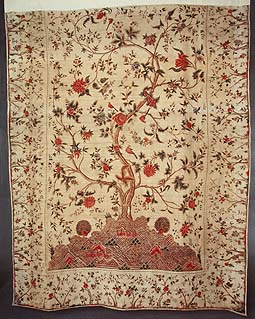| 1.
|
Explain
how the rugmaking of the nomads was a medium for self-expression
and communication between tribes people and urban people.
|
| 2. |
Identify the external factors that have influenced the
textile design of the nomads of Central Asia. |
| 3. |
Record
in point form the following influences on nomadic
textile design in Central Asia, using the following
headings:
- geography
- techniques
- availability
of resources
- religious
practices
- skills
of the artisan.
|
4.
Using the gul motif below, colour a grid to provide
a pattern for a weaver.

5.
Outline how the textile design of the nomads of Central
Asia has influenced:
apparel
design
interior design
textile art design
non-apparel design.
6. Explain the properties of wool fibre that enable felting
to occur.
7. Make a colour chart showing the main colours used in
nomadic textiles.
8. Write instructions for making ikat.
| 9. |
The
tree of life is a common motif used in many textile
arts and across many cultures. Contrast Indian and Central
Asian versions referring to Figure
5, Figure 14 and
Figures 15 and 16 below. |

Fig.
15 Eighteenth century cotton Indian tree of life palempore.
Painted and dyed cotton palempore (bed cover or curtain)
with classic 'tree of life' design, made in Palakollu,
Andrha Pradesh, on the Coromandel Coast of India between
1740 and 1780. The 'tree of life' motif is an ancient
and universal symbol representing the life force between
earth and sky, and the centrality of the world within
the cosmos. Powerhouse Museum Collection. A8201
|

Fig.
16 Late 20th century painted cotton Indian tree of life
coverlet.
Painted and dyed cotton coverlet with a stylised 'tree
of life' design, made by J. Niranjan Chetty in Sri Kalahasti
village Andrha Pradesh, on the Coromandel Coast of India
in 1985. The art of kalamkari, which means pen-work,
has been practised in India for centuries and the skills
have been passed down through the generations. Powerhouse
Museum Collection. 85/1687 |
| 10. |
During
those many centuries, the material culture of the
Central Asian people: nomadic, semi-nomadic and oasis-dwelling,
has developed in response to practical and aesthetic
human needs, and changed in response to internal pressures
and external influence. (Sumner, 1999: 7)
Identify
the functional and aesthetic needs and the internal
pressures and external influence of Central Asia.
Present as a summary in a table.
|
Further
reading
Highly recommended
Sumner, C. (1999) Beyond
the Silk Road – arts of Central Asia, Powerhouse
Museum, Sydney. Available from Publications.
Contemporary
issues
Piroch, S. (1994) The Mother of all (Part I), Textile
Fibre Forum, No 41, p. 7.
Piroch, S. (1995) The Mother of all (Part II), Textile
Fibre Forum, No 42, pp. 48–49.
Houbein, L. (1992) Designing on the needle, Textile Fibre
Forum, No 34, pp. 22–23, 58.
Schapira, S. (1999) Susan Schapira - Contemporary Reverse
Applique, Textile Fibre Forum, No 56, p.10.
Feltmaking
Stirling, P. (1997) Layered messages from Turkey, Textile
Fibre Forum, No 48, pp. 28–29.
Lawrence, K. (1998) Twisted, tangled and matted - Feltworks
by Ing Flint, Textile Fibre Forum, No 51, pp. 13,
25.
Shuttleworth, A. (1994) Felting without a fuss, Textile
Fibre Forum, No 39, p. 55.
Tradition
O'Bannon, G. W. (1998) From Desert and Oasis: Arts of
the people of Central Asia, Georgia Museum of Art, University
of Georgia. Available via the following web site:
http://www.uga.edu/gamuseum/Publications.html
Roberts, M. (1992) Textiles of Central Asia: Ikats and embroideries,
Textile Fibre Forum, No 33, p. 60.
Yurts
Van Zuilen, M. (1998) Have yurt – will travel, Textile
Fibre Forum, No 53, pp. 8–10, 58.
Hansen, K. (1994) The Aussie Yurt Story, Textile Fibre
Forum, No 39, pp. 54, 59.
Links
www.rugreview.com
www.silk-road.com
References
Houbein, L. (1992) Designing on the needle, Textile Fibre
Forum, No 34, pp. 22–23, 58.
Lawrence, K. (1998) Twisted, tangled and matted - Feltworks
by Ing Flint, Textile Fibre Forum, No 51, pp. 13,
25.
O'Bannon, G. W. (1998) From Desert and Oasis: Arts of
the people of Central Asia, Georgia Museum of Art, University
of Georgia.
Schapira, S. (1999) Susan Schapira - Contemporary Reverse
Applique, Textile Fibre Forum, No 56, p. 10.
Sumner, C. (1999) Beyond the Silk Road – arts of
Central Asia, Powerhouse Museum, Sydney.
|